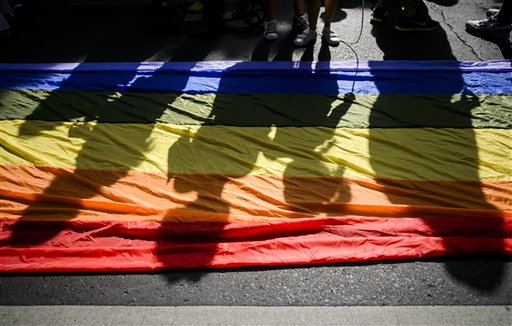
People cast shadows on a rainbow flag during a Gay Pride Parade in Bucharest, Romania, Saturday, May 23, 2015. (Andreea Alexandru/Mediafax via AP)
June is Pride Month, observed this month because the Stonewall riots occurred in June 1969. Stonewall is commonly thought of as the birth of the public, modern LGBT rights movement.
Here are five things to keep in mind and several examples to inspire you as you cover LGBT stories this Pride month.
1. There is no one gay narrative or trans narrative.
Empowering LGBT people to tell their own stories can provide a greater diversity of voices and show a range of experiences, as Katy Bergen did for the Sarasota Herald Tribune’s TransSarasota and The New York Times is doing on an ongoing basis in its series Transgender Today.
2. It’s important to talk about LGBT cultural icons, but it’s also important to be aware of the role of class in these narratives.
Resources and support available to a celebrity who comes out as LGBT may not be available to an ordinary person who comes out. Remain aware of the ways race, class, ability, gender, sexual orientation, gender identity, religion and age intersect and affect a person’s experience.
3. It might seem like the fight for same-sex marriage is over, but that depends on where you live.
Thirty-six states now allow same sex marriage. This Pew map shows which states allow same-sex marriage and how this has changed over time. There are also laws that affect same sex couples even in states that allow marriage. The legal backing of same-sex marriage is not enough, Trudy Ring argued in the Advocate, because employment discrimination can still make it dangerous to marry in some cases. “Only a minority of states ban job discrimination against LGBT people, and no national law prohibits it,” Ring wrote.
4. There are readymade feature stories to write about Pride parades full of rainbow tutus, balloon-covered floats and beaming, flag-waving newlyweds in many cities. But there are a lot of cities where it’s not safe or not legal to be out.
This is the 10th year in a row that Russian activists have attempted to hold a gay pride parade and been denied, Reuters reported. This year, 20 people were detained.
Demonstrators were able to unfurl a rainbow flag for a short time – reading “Make love not war” – but they were also attacked by an anti-gay group before riot police ripped the flag away.
5. There are so many issues that matter to LGBT communities beyond what happened on “Orange is the New Black” and what Kanye West thinks.
Also, writing about a parade is not the same as covering a community. Ask what stories are going unreported in your own community. Here are some ideas:
—Homelessness:
LGBT people experience homelessness at disproportionate rates, according to The National Coalition for the Homeless. Pam Fessler’s NPR story on Ruby Corado, who runs Casa Ruby, a shelter for transgender people who need help with housing, employment and accessing services, is a profile of someone attempting to deal with the problem of homelessness among transgender people.
She recently opened two more houses, with the help of grants from the city and foundations. One house is a transitional home for gay and transgender homeless youth. The other is for homeless adults. Many transgender people say they have a difficult time staying in homeless shelters, which are usually designated for either men or women.
— Discrimination — at work, in public services, by law enforcement
Transgender women detained by immigration officials are often housed with men, a 2014 Fusion investigation found:
A six-month Fusion investigation found that conditions for transgender women locked up by Immigration and Customs Enforcement (ICE) are often humiliating, dangerous, and even deadly.
On any given night, some 75 transgender prisoners are detained by ICE.
— Violence against LGBT people
When I wrote about how to write about transgender people in 2013, Jos Truitt of Feministing told me that, unfortunately, “The main way you see trans people show up in the media is as dead bodies.” A 2012 National Coalition of Anti-Violence Programs study found that transgender women of color experience violence at much higher rates than do other LGBT people. If you cover crimes against LGBT people, don’t stop at the individual act of violence. Look for trends and cover the community after other outlets abandon the story.
—Discriminatory legislation
Everyone heard about Indiana’s anti-gay “religious freedom” legislation. But Indiana is not the only state that has passed a law like this, and there are bills targeting transgender people as well. Katy Steinmetz of TIME wrote about the trend of state lawmakers attempting to ban transgender people from using the bathroom assigned to the gender with which they identify.







Comments